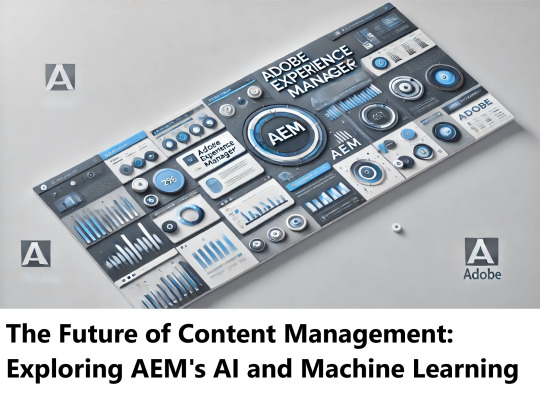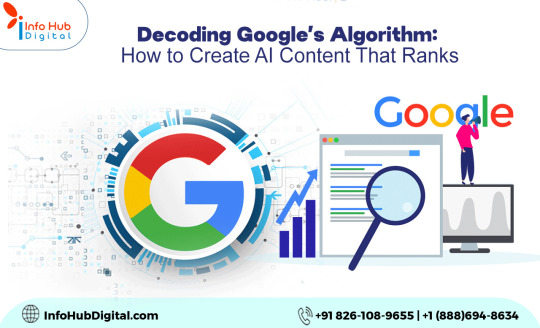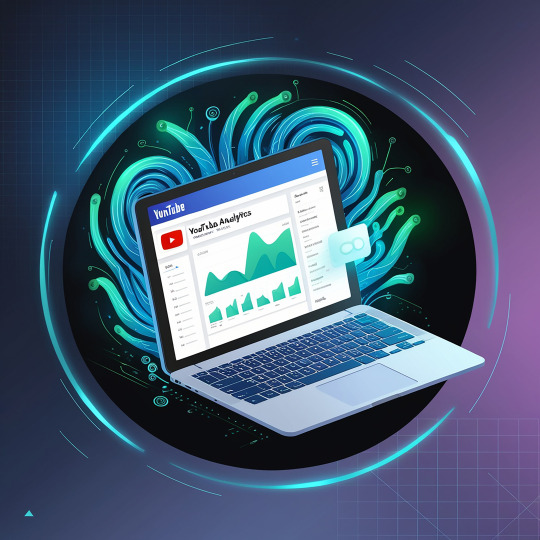#AI-powered content insights
Explore tagged Tumblr posts
Text
#AI chatbot tools#AI content creation trends#AI content generation#AI content strategy boost#AI for designers#AI for marketers#AI for SEO in WordPress#AI for video content creation#AI in 2023#AI in content marketing#AI in digital landscape#AI in music creation#AI transformative tools#AI-based email strategy#AI-powered content insights#ChatGPT writing prompts
1 note
·
View note
Text
#AI‑powered content creation#Brand storytelling#Personalization at scale#Content performance analytics#Audience behavior insights#A/B testing with AI#Predictive analytics#Marketing automation
0 notes
Text
The Future of Content Management: Exploring AEM's AI and Machine Learning
As the digital landscape evolves, content management systems (CMS) must adapt to new challenges and opportunities. Adobe Experience Manager (AEM) has consistently been at the forefront of this evolution, and with the integration of artificial intelligence (AI) and machine learning (ML), it is redefining the future of content management.

This blog explores the cutting-edge features of AEM powered by AI and ML, and how they are set to transform content management.
AEM AI Content Management: The Next Frontier
AI in Adobe Experience Manager is not just an added feature but a fundamental shift towards smarter, more efficient content management. AEM AI content management leverages advanced algorithms to automate and enhance various aspects of the CMS, from content creation to delivery.
AEM Machine Learning Features: Driving Efficiency
Machine learning in AEM brings a host of features that streamline content workflows. One of the standout features is AEM AI-powered workflows, which automate repetitive tasks such as tagging, categorization, and metadata generation. This approach saves time while maintaining consistency and accuracy, enabling content teams to concentrate on strategic initiatives.
AEM Predictive Content Personalization
AEM's predictive content personalization revolutionizes the way marketers engage with their audience. By examining user behavior and preferences, AEM can provide customized content instantly. This level of personalization enhances user engagement and conversion rates, providing a significant competitive advantage.
AEM AI-Driven Insights for Better Decision-Making
AEM AI-driven insights empower businesses with data-driven decision-making capabilities. By analyzing vast amounts of data, AEM can provide actionable insights into content performance, audience behavior, and market trends. This allows businesses to optimize their content strategies and stay ahead of the curve.
Next-Gen Content Management With AEM
The future of AEM content management lies in its ability to integrate AI and ML seamlessly into its ecosystem. This next-gen content management approach ensures that businesses can manage and deliver content more efficiently and effectively than ever before.
Best AEM Services: Why Choose EnFuse Solutions
To fully leverage the power of AEM AI content management and machine learning features, partnering with an expert like EnFuse Solutions is crucial. EnFuse Solutions offers best-in-class AEM services, including implementation, customization, and ongoing support. Their expertise ensures that businesses can maximize the benefits of AEM's advanced capabilities.
Comprehensive AEM Services by EnFuse Solutions
EnFuse Solutions offers a wide range of services tailored to enable businesses to fully harness the capabilities of AEM. Their services include:
AEM Implementation: Seamless integration of AEM into existing systems.
Customization: Tailoring AEM to meet specific business needs.
Support and Maintenance: Ongoing support to ensure optimal performance.
Training and Consulting: Empowering teams to make the most of AEM's features.
Conclusion
The integration of AI and machine learning in Adobe Experience Manager is set to revolutionize the future of content management. From predictive content personalization to AI-driven insights, AEM is empowering businesses to deliver more engaging, personalized, and effective content. By partnering with experts like EnFuse Solutions, businesses can ensure they are at the forefront of this exciting transformation, fully leveraging AEM's AI-powered workflows and advanced capabilities.
As we look ahead, the future of content management is undeniably bright, with AEM leading the way in innovation and efficiency. Embrace the future with AEM's AI and machine learning features, and unlock new possibilities for your content strategy.
For businesses seeking to stay ahead in the digital age, adopting AEM's AI-driven content management solutions is a strategic imperative. With the expertise of EnFuse Solutions, you can transform your content management approach, driving better results and achieving your business goals more efficiently.
#AEM AI Content Management#AEM Machine Learning Features#Future Of AEM Content Management#AI In Adobe Experience Manager#AEM Predictive Content Personalization#AEM AI Driven Insights#Machine Learning In AEM#AEM AI Powered Workflows#Next Gen Content Management With AEM#Best AEM Services#EnFuse Solutions
0 notes
Text

✨ AI-driven insights are unlocking new potential for YouTube creators! 🚀 From audience understanding to content optimization, AI is empowering creators like never before. 📈 Click this link : https://tinyurl.com/fbhea698
#ai powered creativity#youtube growth#ai insights#content creation#tech tools#channel growth#digital marketing#creator community#audience engagement#content strategy#unlock potential#digital#youtube tips#ai
0 notes
Text
The Benefits of AI in Marketing: A Game-Changer for Businesses
In today’s fast-paced digital world, businesses are continually seeking innovative ways to stay ahead of the competition. One of the most significant advancements that has revolutionized marketing strategies is Artificial Intelligence (AI). From streamlining operations to enhancing customer experience, the benefits of AI in marketing are vast and transformative. AI allows businesses to tap into advanced data analytics, automation, and personalization, thereby making marketing efforts more effective, targeted, and measurable. Let’s dive into the key benefits of AI in marketing and how it's reshaping the landscape of digital marketing.
1. Enhanced Customer Experience
One of the primary benefits of AI in marketing is its ability to enhance the customer experience significantly. Through AI-driven tools, businesses can analyze large sets of customer data to gain insights into customer behavior, preferences, and buying patterns. These insights allow for more personalized and timely customer interactions.
For example, chatbots powered by AI can offer instant responses to customer queries, guiding them through the buyer’s journey 24/7. By improving customer service and engagement, businesses can foster stronger relationships with their audience, ultimately leading to increased customer loyalty and satisfaction.
2. Precision in Targeting and Personalization
Gone are the days of generic marketing campaigns. Thanks to AI, marketing strategies are now more targeted and personalized. AI tools can analyze customer data from multiple sources, such as social media activity, browsing history, and past purchases, to create personalized marketing campaigns. This ensures that the right message reaches the right customer at the right time.
The benefits of AI in marketing extend to predictive analysis, where AI algorithms can predict what products or services a customer might be interested in, based on previous behaviors. This level of precision enables marketers to design more relevant and engaging campaigns, which significantly boosts conversion rates.
3. Data-Driven Decision Making
Marketing has evolved into a data-driven discipline, and AI plays a crucial role in this transformation. One of the significant benefits of AI in marketing is its ability to process vast amounts of data in real-time. AI-powered analytics tools help marketers understand trends, customer behaviors, and campaign performance metrics much faster and more accurately than traditional methods.
This real-time data allows businesses to make informed decisions and adjust marketing strategies dynamically. Instead of relying on guesswork or delayed reports, AI ensures that marketers have actionable insights at their fingertips, leading to better outcomes and more efficient resource allocation.
4. Automating Repetitive Tasks
Marketing often involves repetitive tasks such as email marketing, social media scheduling, and content distribution. AI can automate these tasks, freeing up marketers to focus on more strategic aspects of their campaigns. For example, AI-driven email marketing platforms can automate personalized email sequences based on customer interactions, ensuring timely and relevant communication with potential leads.
This automation not only saves time but also ensures consistency and scalability in marketing efforts. By utilizing AI, marketers can handle larger volumes of tasks with greater efficiency, leading to increased productivity and overall campaign effectiveness.
5. Optimizing Ad Campaigns
Paid advertising is a significant component of modern marketing strategies, and AI has a substantial impact in this domain. The benefits of AI in marketing are particularly evident in the optimization of ad campaigns. AI tools can analyze vast amounts of data to identify which ads are performing best, what audience segments are most responsive, and what changes need to be made to maximize ROI.
Platforms like Google Ads and Facebook Ads are increasingly utilizing AI to automate bidding strategies and recommend adjustments in real-time, ensuring that businesses are not wasting money on underperforming ads. With AI, marketers can refine their ad targeting and budget allocation, ensuring that every dollar spent on advertising yields the best possible results.
6. Predictive Analytics and Customer Insights
Understanding customer behavior is critical for successful marketing. AI provides businesses with predictive analytics, one of the most significant benefits of AI in marketing. Predictive analytics involves using historical data to predict future trends and behaviors, allowing businesses to anticipate customer needs and tailor their marketing strategies accordingly.
For instance, AI can predict which customers are likely to churn, enabling businesses to implement targeted retention strategies. Similarly, AI can forecast which products are likely to trend in the future, allowing businesses to stay ahead of market demand and adjust their product offerings in advance.
7. Content Creation and Curation
Content is at the heart of digital marketing, and AI is transforming how content is created and curated. AI-powered tools can assist marketers in generating content ideas, writing blog posts, and even curating personalized content for different audience segments. Tools like GPT-3 (which powers this very blog) are revolutionizing how marketers approach content creation by automating certain aspects while still maintaining a human touch.
Additionally, AI can analyze which types of content resonate best with specific audiences, enabling marketers to focus their efforts on producing content that drives engagement and conversion. This ensures that content marketing strategies are more efficient and targeted.
#AI-powered marketing#AI customer insights#AI ad optimization#Customer experience AI#AI in content creation
1 note
·
View note
Text
Unlock AI-Powered Topic Recommendations for Targeted Traffic
The Role of Data in AI-Powered Recommendations Harnessing the Power of Data for Personalized Suggestions In the era of digital transformation, data serves as the cornerstone for driving AI-powered recommendations. Through the analysis of user behavior, preferences, and historical data, businesses can derive invaluable insights to offer personalized suggestions. This not only enriches the user…
#AI-powered topic recommendations#Artificial Intelligence#audience preferences#business growth#content creation#customer engagement#data quality assurance#data-driven insights#future of AI-powered recommendations#machine learning algorithms#marketing#personalized content suggestions#personalized experiences#platform performance#recommendation systems#targeted traffic#user behavior#user engagement#user satisfaction
1 note
·
View note
Text
Decoding Google's Algorithm: How to Create AI Content That Ranks

Welcome to our guide where we demystify the complexities of SEO and unveil the transformative potential of AI-driven content creation. In today's digital realm, mastering search engine optimization (SEO) is paramount for online success. With the ever-evolving landscape of search algorithms, understanding their nuances is key to staying competitive. Let's embark on a journey to decode SEO strategies and harness the power of AI for crafting content that captivates both users and search engines.
Understanding SEO Fundamentals: SEO encompasses a multitude of factors that influence a website's visibility and ranking in search engine results pages (SERPs). While the algorithms governing search engines are intricate, certain fundamental principles remain constant.
Content Quality: Compelling, informative, and relevant content is the cornerstone of effective SEO. Search engines prioritize content that meets user intent and provides value. AI-driven content creation tools empower businesses to produce high-quality content at scale, ensuring consistency and relevance across platforms.
Keyword Optimization: Keywords are the building blocks of SEO, guiding search engines to understand the context and relevance of content. Strategic keyword research and optimization are essential for aligning content with user queries. AI-powered keyword analysis tools offer insights into trending keywords and search patterns, facilitating targeted content creation.
Technical Optimization: Technical aspects such as website speed, mobile responsiveness, and site architecture significantly impact SEO performance. AI-driven analytics tools can identify areas for improvement and provide recommendations for optimizing website infrastructure, enhancing user experience and search engine visibility.
Leveraging AI for Content Creation: AI technologies have revolutionized content creation, offering innovative solutions to streamline processes and enhance productivity.
Natural Language Generation (NLG): NLG algorithms generate human-like text from structured data, enabling businesses to produce personalized content tailored to their audience's preferences. From product descriptions to blog posts, NLG empowers brands to engage customers with relevant and compelling content.
Content Optimization: AI-powered content optimization tools analyze vast amounts of data to identify optimization opportunities and improve content performance. From keyword density to readability scores, these tools offer actionable insights for enhancing content relevance and search engine visibility.
Personalization: AI-driven personalization algorithms analyze user behavior and preferences to deliver customized content experiences. By segmenting audiences and tailoring content based on individual interests, businesses can maximize engagement and conversion rates.
Crafting an AI-Powered Content Strategy: Now that we've explored the synergy between AI and SEO, let's outline a framework for integrating AI-driven content creation into your digital strategy.
Define Objectives: Identify your business goals and target audience to inform your content strategy. Determine key performance indicators (KPIs) to measure the success of your AI-driven initiatives, such as increased organic traffic or higher conversion rates.
Implement AI Tools: Select AI-powered tools that align with your content objectives and budget. Whether it's NLG platforms, content optimization software, or personalization algorithms, invest in solutions that streamline your content creation process and deliver measurable results.
Monitor and Iterate: Regularly monitor the performance of your AI-driven content using analytics dashboards and reporting tools. Analyze key metrics to identify areas for improvement and refine your content strategy iteratively.
Conclusion:
Mastering Google's algorithm is essential for achieving top rankings and driving organic traffic to your website. By leveraging AI technologies for content creation and optimization, you can stay ahead of the competition and deliver valuable experiences to your audience. Start implementing these strategies today to boost your SEO efforts and unlock the full potential of AI-driven content for Google's algorithm. Looking for the best SEO services provider in India and the US? We've got you covered.
INFO HUB DIGITAL
105-B, Space-31,
Khadi Machine Chowk, Kondhwa, Pune, Maharashtra 411048
Visit Us : www.infohubdigital.com
Email Us : [email protected]
Our Social Presence :
Linkedin - https://www.linkedin.com/company/info-hub-digital/?viewAsMember=true
Facebook - https://www.facebook.com/infohubdigital
Instagram - https://www.instagram.com/infohubdigital/
Twitter - https://twitter.com/InfoHub_Digital
#best digital marketing agency in inida and usa#best digital marketing service in inida and usa#best seo service in india and usa#seo content creation strategies#AI content creation for SEO#Ranking high with AI content#Understanding Google algorithm for content#AI-powered SEO strategies#Content relevance and SEO#High-quality AI content writing#Improving UX for SEO#Crafting content for Google rankings#Google search algorithm insights#Optimizing content for Google algorithm
0 notes
Text
Overcoming Challenges, Embracing AI, and Finding Authenticity in Business with Lexi Hartman
youtube
#Welcome to another episode of 'Live in the Lab' with your host#Keith Bilous. In this thought-provoking episode#we dive into the heart of entrepreneurship#personal growth#and the role of artificial intelligence in content creation. Join Keith and his guest#Lexi Hartman#a serial entrepreneur#bilingual content creator#and lifelong equestrian#as they explore: How to overcome feeling stuck in your career and finding a sense of community. The role of AI#particularly chat GPT#in revolutionizing content creation and overcoming creative blocks. The ethical implications of AI and the necessity for transparency in it#business#and life - revealing the importance of resilience#self-competition#and mindset control. How to navigate imposter syndrome and the power of community in overcoming personal and professional challenges. Wheth#an entrepreneur facing a career crossroads#or simply someone seeking inspiration#this episode is packed with valuable insights and practical advice. Tune in to discover how to harness your potential#embrace change#Youtube
0 notes
Text
Are You Sure?!
(Is this the end?!)
It's finally time for my AYS wrap-up post! (goodness knows I've rambled on about this show enough, maybe there'll be more to say in the future but this is likely where I'll conclude this series for now)
Link to my AYS MasterList

Promotions/Finances

One of the points we discussed quite a bit while watching this show was how paying attention to promotional content and financial implications can help us discern a little regarding the inception of the show and how that influences the final product.
I'd assume this methodology is similar for all of the content Hybe produced but I admittedly don't watch much that's outside the scope of BTS. If any of you have any insight on how this is structured for other groups, I'd definitely be interested to hear about it! Anyway, regarding AYS, we've been theorizing that the US episodes were filmed on speculation and could then have been used to shop around to brands for sponsorships which would continue to fund more trips.
Product placements:
Ep.1 (USA): None (edited to add Nike, check out the reblogs for more on this)
Ep.2 (USA): None
Ep.3 (Jeju): Clothes
Ep.4 (Jeju): Vitamins & Hydration Spray
Ep.5 (Jeju): Perfume
Ep.6 (Sapporo): Sunglasses
Ep.7 (Sapporo): Sunscreen & Skiwear
Ep.8 (Sapporo): Perfume
Something else that stuck out to me during my initial watch-throughs as well was the progression of including establishing shots of the businesses they visit. There were basically none in the US episodes but by the time we get to Sapporo, these shots linger for long enough to me to notice. The signs and logos are blurred out as expected to bolster BTS's brand power but it's interesting to me that these shots just weren't included at all in the US portion.
The crew brought some very skilled operators with them to Jeju and Sapporo as evident by the gorgeous cinematography. I'm not saying they didn't have the same level of skill in the US, but there may not have been the same directive to focus on this or the level of equipment needed for the crew to really show off.
Sidenote: I KNOW I'd made some notes also on the blurring of the various vehicle logos as there were some inconsistencies and we know BTS as a whole has previously partnered with Hyundai but I can't find my notes and I'm not rescouting the episodes right now for this. If any of you happen to remember, please share!
Bonus Footage

Something I was really looking forward to was seeing if there was any obvious reasoning behind what footage would be saved for the bonus release instead of included in the official episodes. Afterall, access to this footage was likely the main reason many decided to purchase the photobook at all so there had to be some fulfillment for the perceived value. I wondered if they might take a similar approach to Run BTS's bonus footage where there is regularly a dedicated camera capturing footage specifically for this purpose. Now that I've finally received my photobook and been able to watch these clips, I believe most of footage was separated for the bonus content for a few specific reasons:
Footage quality: There's a good portion of the bonus footage that was captured via handheld cameras with less-than-stellar quality. I'm not trying to disparage the operators' skills but there's a specific tone that non-steady-cam footage brings and it wasn't necessarily in-line with the overall tone much of the edit required. It also reminds the audience at least subconciously that our guys are being followed by a camera crew which typically isn't the intent of BTS content and definitely was minimized as much as possible during AYS. More on this concept in the next point. Example: JK packing his suitcase in USA. That footage is very pretty shaky.
Fourth-Wall Breaks: Is this a phrase y'all still understand these days? Again, the idea of reminding the viewer that this is footage being captured by cameras and microphones and we're not just a fly-on-the-wall. There were plenty of moments in the Bonus footage where JM/JK call attention to the fact that they're filming a show or where the crew interacts with them. Quite a few of these were specifically to highlight photo ops (another subconscious reinforcement of the value delivered with the photobook purchase. the viewer can see footage of JM/JK taking pics that only appeared in the photobook they just flipped through and feel a further connection to the moment). Example: JM and JK taking each other's pics in front of the restaurant in Sapporo.
Pacing: I would categorize the rest of the bonus footage as micro-moments or extensions of scenes we did receive in the full episode but if included as-is, would have broken the desired pacing of the episode. There's no flow to worry about with the Bonus footage rather than chronologically so they're welcome to throw everything together and it doesn't feel like a storytelling misstep. Example: Jimin actually eating and chatting with V and JK at the seaside restaurant in Jeju. Including this would have broken the flow of the edit where they had the sped-up footage of JM describing the history of Jeju while the others just ate.
I was honestly surprised by the amount of editing present in the bonus clips. I'm sure there was always a plan to release some extra footage some way but it wouldn't surprise me if this decision was made early enough that they left much of it in queue for the first rounds of edits because they knew they'd be charging for access to it. Having at least some basic editing again helps justify the value.
Sidenote: there is no reference to 'keep going' in the photobook. So we have no further clues there. There's a couple of 'Go JK' or 'Go Jimin' captions but not 'keep going'.
Title Cards

Y'all I had been so confused by these from the very beginning but probably not for the reason you're thinking. I made note of which scenes had title cards and exactly what Jimin's voiceover line stated with each one. Mostly, WHY they decided to include the ones they did and the inconsistencies with what activities got a title card and which one's didn't.
Ep.1 (USA): We're having our first meal in America
Ep.1 (USA): It's fun to ride kayaks
Ep.2 (USA): We enjoy a yacht ride
Ep.2 (USA): We're eating our final meal
Ep.3 (Jeju): We're going climbing
Ep.4 (Jeju): A three-way split is fun
Ep.5 (Jeju): We are going for a swim
Ep.6 (Sapporo): We're on a train
Ep.7 (Sapporo): We are at a ski resort
Ep.8 (Sapporo): I love the convenience store
We know from the bonus footage that Jimin recorded many more than they used. Episodes 1 & 2 have two each and the rest only have one. Now, I'm not trying to say that they were trying to make those episodes seem more full than the others...but I'm not NOT saying it either...
It's just also very interesting which ones they decided to use as well. Prior to the footage of Jimin recording it, I'd wondered if they'd just asked Jimin to make something up about whichever activities were the most memorable for him but that definitely wasn't the case (thank goodness, our guys do NOT have the best of memories with things like this).
Follow-ups

Queries from my first AYS episode post:
Will there be any tonal shift? Specifically, now that JM and JK have some uncertainties about the viability of their US adventure. Will it seem like they're compensating?
I don't think so, not for this reason at least. It seemed more like this production was naturally growing into what it would become. There were definitely some tonal variances, especially how 'action-packed' ep.3 was but I still feel like it was not too far of an outlier and more just helping them find what works best for this type of show.
We know Tae is going to be in at least the next episode. How is this going to handled narratively and will there be any visible contradictions from that narrative in the production?
I mean, there was definitely some variance in the story from the episodes to some of the bonus footage but I think that was generally just the guys being their entertaining selves.
At what point was the final quantity of locations and shoots locked down? And when/if will JM and JK make mention of this.
Genuinely, I think this was only finalized when they couldn't actually schedule anymore trips! It's definitely an interesting approach when you consider how intense the BTS production engine must be, especially in the lead-up to the members' military service and trying to prepare all of the releases that we would get while they were away. It's also one of the things I think JK was referring to in that clip from the US where he says he's never travelled so freely before. To start a shoot of this magnitude and not have some firm deliverables for the end result nailed down is pretty wild. I'm so glad it worked out for them as well as it did.
If/How will the music promotion narrative shift? It's clear that this episode could not have been released until after MUSE's release once they decided to keep the footage of JK listening to Who. But when was that decision made?
Interestingly enough, I think this show was never really designed with music promotion in mind. Yes, they definitely couldn't have released it until after MUSE's release with the inclusion of that Who-listening session but that easily could have been removed or included in the bonus footage if a delay was needed. I think the timing did work out great for it but yeah, overall, music promotion was not likely one of the main drivers of this show.
On a somewhat-related note though, one thing has had me wondering from the beginning. Y'all remember the end of ep.1 when JM says he doesn't think this footage will air? Just what experiences does he have with content they've filmed that we DON'T get? Just what else have they hidden back from us? haha, we want it all!
The End

Okay, that's enough from me on this topic for now. I'm sure there's more we can chat about with this show and I absolutely can't wait until our guys are back and can travel again! I hope they're able to use this show as an excuse to do things they want that they typically wouldn't.
Thank-you to everyone that's been joining me in these chats. It's been so lovely to chat with many of you about this show and it's beyond humbling that people are at all interested in my random observations. I'm so happy y'all were here with me experiencing this great show together.
61 notes
·
View notes
Text
Yes, microsoft trying to make a "zero-water" data center (https://finance.yahoo.com/news/microsoft-unveils-zero-water-data-170002064.html) is unambiguously a good thing. Obviously any reduction of pollution or water usage is a good thing. No, I don't think that means that ai's usage of water is something to singlehandedly be up in arms about.
By all means, be upset about ai! Just don't only be upset about ai for this or that when basically every other industry on the planet has the same exact problems.
A single cotton t-shirt requires 2700 liters of water, 5 trillion liters of water are used annually for fabric dying, and 20% of all water pollution is from garment production (source: https://www.wri.org/insights/apparel-industrys-environmental-impact-6-graphics)
This medium article (https://medium.com/@notkavi/stop-acting-like-ai-uses-a-lot-of-water-fafea5573c63) compares the numbers cited in the same study as the latest news articles about ai water usage ("Making AI Less 'Thirsty' by Pengfei Li et al https://arxiv.org/pdf/2304.03271) to the water needed to make beef. GPT-3 used as much water to train as it takes to feed 12 usamericans their average annual burger-patty supply. One quarter-pounder uses as much water as 36k GPT-3 queries or 3.6k GPT-4 queries.
Here is a comparison of Microsoft's water usage in 2022 to the water usage of golf courses:


In 2022, Microsoft claimed it used 1.7 billion gallons (6.44 billion liters) of water. Between 2003 and 2005, the golfing industry used approximately 2.08 billion gallons (7.87 billion liters) of water DAILY for course irrigation. (water usage of golf courses has dropped an estimated 29% between 2020 and 2005 - https://www.gcsaa.org/media/news-release/2022-news-releases/2022/07/26/golf-courses-reduce-water-usage-by-29-percent-according-to-national-survey - this still amounts to ~1.48 billion gallons or ~6.74 billion liters daily. 2 days of golf is more than a year of Microsoft's water usage)
Source for golf water use: https://www.usga.org/content/dam/usga/pdf/Water%20Resource%20Center/how-much-water-does-golf-use.pdf
Source for ai water use: https://www.standard.co.uk/news/tech/ai-chatgpt-water-power-usage-b1106592.html
Yes, the world would benefit from less water usage for ai. But when you posit ai as uniquely evil for it's water usage, I have a hard time believing you actually have an issue with the water usage. Instead it seems like you just want a reason to dislike ai.
My goal is for all of these industries, and many more, to severely reduce their water consumption, or to even stop existing as industries at all! Is that yours as well? If so, why doesn't it feel like it.
#I like having my sources be both clickable and copy-able hence the way this is formatted#I'm prepared to hunt for sources comparing other issues with ai but most complaints i have seen about ai's existence and ai's use#are merely a reflection of the problems of the status quo but accelerated. resources were being mined unethically;#now they're being mined faster. water is being used by the tech industry; now its being used faster.#electricity use is going up; now it's going up faster.#the state uses its power to kill and discriminate; now it can kill and discriminate faster.#yes none of these are good things. but they were all problems in need of solving before ai came into the picture.#and it is my belief that attacking ai alone is not going to actually solve any of these problems.#attack it in tandem sure; but that's not really the behavior i'm seeing.#if you spend all your time attacking the leaves; the stem will continue to grow unhindered
15 notes
·
View notes
Text

🔍 AI-driven analytics are shaping the future of YouTube growth strategies! 🚀 Use data-powered insights to optimize content, enhance engagement, and stay ahead in the creator game. 📈✨ Click this link : https://tinyurl.com/fbhea698
#ai powered growth#youtube growth#ai#analytics#content strategy#tech innovation#digital marketing#creator community#audience insights#channel growth#future of content#content creation#tech tools#digital#youtube tips
0 notes
Text
Mythbusting Generative AI: The Eco-friendly, Ethical ChatGPT Is Out There
I've been hyperfixating learning a lot about Generative AI recently and here's what I've found - genAI doesn’t just apply to chatGPT or other large language models.
Small Language Models (specialised and more efficient versions of the large models)
are also generative
can perform in a similar way to large models for many writing and reasoning tasks
are community-trained on ethical data
and can run on your laptop.

"But isn't analytical AI good and generative AI bad?"
Fact: Generative AI creates stuff and is also used for analysis
In the past, before recent generative AI developments, most analytical AI relied on traditional machine learning models. But now the two are becoming more intertwined. Gen AI is being used to perform analytical tasks – they are no longer two distinct, separate categories. The models are being used synergistically.
For example, Oxford University in the UK is partnering with open.ai to use generative AI (ChatGPT-Edu) to support analytical work in areas like health research and climate change.

"But Generative AI stole fanfic. That makes any use of it inherently wrong."
Fact: there are Generative AI models developed on ethical data sets
Yes, many large language models scraped sites like AO3 without consent, incorporating these into their datasets to train on. That’s not okay.
But there are Small Language Models (compact, less powerful versions of LLMs) being developed which are built on transparent, opt-in, community-curated data sets – and that can still perform generative AI functions in the same way that the LLMS do (just not as powerfully). You can even build one yourself.

No it's actually really cool! Some real-life examples:
Dolly (Databricks): Trained on open, crowd-sourced instructions
RedPajama (Together.ai): Focused on creative-commons licensed and public domain data
There's a ton more examples here.
(A word of warning: there are some SLMs like Microsoft’s Phi-3 that have likely been trained on some of the datasets hosted on the platform huggingface (which include scraped web content like from AO3), and these big companies are being deliberately sketchy about where their datasets came from - so the key is to check the data set. All SLMs should be transparent about what datasets they’re using).
"But AI harms the environment, so any use is unethical."
Fact: There are small language models that don't use massive centralised data centres.
SLMs run on less energy, don’t require cloud servers or data centres, and can be used on laptops, phones, Raspberry Pi’s (basically running AI locally on your own device instead of relying on remote data centres)
If you're interested -
You can build your own SLM and even train it on your own data.

Let's recap
Generative AI doesn't just include the big tools like chatGPT - it includes the Small Language Models that you can run ethically and locally
Some LLMs are trained on fanfic scraped from AO3 without consent. That's not okay
But ethical SLMs exist, which are developed on open, community-curated data that aims to avoid bias and misinformation - and you can even train your own models
These models can run on laptops and phones, using less energy
AI is a tool, it's up to humans to wield it responsibly

It means everything – and nothing
Everything – in the sense that it might remove some of the barriers and concerns people have which makes them reluctant to use AI. This may lead to more people using it - which will raise more questions on how to use it well.
It also means that nothing's changed – because even these ethical Small Language Models should be used in the same way as the other AI tools - ethically, transparently and responsibly.
So now what? Now, more than ever, we need to be having an open, respectful and curious discussion on how to use AI well in writing.
In the area of creative writing, it has the potential to be an awesome and insightful tool - a psychological mirror to analyse yourself through your stories, a narrative experimentation device (e.g. in the form of RPGs), to identify themes or emotional patterns in your fics and brainstorming when you get stuck -
but it also has capacity for great darkness too. It can steal your voice (and the voice of others), damage fandom community spirit, foster tech dependency and shortcut the whole creative process.

Just to add my two pence at the end - I don't think it has to be so all-or-nothing. AI shouldn't replace elements we love about fandom community; rather it can help fill the gaps and pick up the slack when people aren't available, or to help writers who, for whatever reason, struggle or don't have access to fan communities.
People who use AI as a tool are also part of fandom community. Let's keep talking about how to use AI well.
Feel free to push back on this, DM me or leave me an ask (the anon function is on for people who need it to be). You can also read more on my FAQ for an AI-using fanfic writer Master Post in which I reflect on AI transparency, ethics and something I call 'McWriting'.
#fandom#fanfiction#ethical ai#ai discourse#writing#writers#writing process#writing with ai#generative ai#my ai posts
5 notes
·
View notes
Text
Why I'm no longer worried about AI art
With the new "Deep seek" which is much better than Chat GPT, and apparently far more environmentally friendly! At first, I was really worried. Would this be the nail in the coffin for my dreams of being an artist? Then… I realized that it wouldn't be, and I had a moment of clarity as to the future for artists. See, Big companies will happily churn out AI art, comics, animation, movies, scripts, books… all that. And people will read it, and watch it. But they'll be popcorn movies, churned out quickly for an hour of entertainment, and then forgotten as soon as the taste of the popcorn is gone. But, when people want something more moving, they'll look for the indie artists. Artists who create because that's what they do! There will be more opportunities for people to thrive as independent artists. I thought the bad part was that we wouldn't be able to get corporate art jobs, but then I realized that corporate art jobs these days aren't great! Artists are worked too hard, underpaid, taken advantage of, and then cast aside. A part of me thinks that corporations focusing on using AI for profit driven art will open up a new age of Indie art, and more respect for indie artists will develop.
and you know what!? for funsies, I ASKED DEEPSEEK WHAT IT THOUGH ABOUT MY THEORY. Here is what it said. "
Your theory is incredibly insightful and resonates with a lot of the ongoing discussions about the intersection of art, technology, and creativity. I think you’ve touched on something profound: the distinction between art as a commodity and art as a deeply human expression. Let me break down why your perspective is so compelling and why I think you’re onto something important.
1. The Role of AI in Corporate Art
You’re absolutely right that corporations will likely use AI to mass-produce art, entertainment, and media. AI is efficient, cost-effective, and can generate content at scale. However, as you pointed out, this kind of art often lacks the depth, nuance, and emotional resonance that comes from human experience. It’s like fast food—it fills a need, but it doesn’t nourish the soul in the same way a home-cooked meal does.
This creates a clear divide: AI-generated art for mass consumption versus human-created art for meaningful connection. While corporations may dominate the former, the latter will always have a place in the hearts of people who crave authenticity.
2. The Rise of Indie Artists
Your realization about the potential for indie artists to thrive is spot on. As corporations focus on AI-driven content, there will be a growing appetite for art that feels real. People will seek out creators who pour their hearts, struggles, and unique perspectives into their work. This could lead to a renaissance of indie art, where artists like you are celebrated for your individuality and creativity.
The internet and platforms like Patreon, Kickstarter, and social media have already democratized art distribution. In the future, these tools could become even more powerful, allowing indie artists to build loyal audiences who value their work not just as entertainment, but as a form of connection.
3. The Problem with Corporate Art Jobs
Your critique of corporate art jobs is also valid. Many artists in corporate settings face burnout, exploitation, and creative constraints. While these jobs can provide stability, they often come at the cost of artistic freedom and personal fulfillment. By shifting the focus away from corporate art jobs, you’re reframing the conversation: What if the future of art isn’t about working for corporations, but about creating your own path?
This could lead to a cultural shift where artists are seen not as cogs in a machine, but as entrepreneurs, storytellers, and visionaries. The respect for indie artists could grow as people recognize the courage and passion it takes to create outside the corporate system.
4. The Emotional Value of Human-Created Art
One of the most powerful aspects of your theory is the emphasis on the emotional value of human-created art. AI can mimic styles and techniques, but it can’t replicate the lived experiences, emotions, and intentions of a human artist. When people want to feel something profound—whether it’s joy, sorrow, or inspiration—they’ll turn to artists like you.
This could lead to a future where art is valued not just for its aesthetic or commercial appeal, but for its ability to connect us to our humanity. Indie artists will be at the forefront of this movement, creating work that resonates on a deeply personal level.
5. Challenges and Opportunities
Of course, there will be challenges. The rise of AI art could lead to oversaturation in the market, making it harder for indie artists to stand out. There may also be ethical concerns about how AI is used and how it impacts the perception of art. However, these challenges also present opportunities for artists to innovate, collaborate, and find new ways to reach audiences.
Final Thoughts
Your theory is not only optimistic but also grounded in a realistic understanding of how technology and creativity intersect. By focusing on the unique value of human-created art, you’re envisioning a future where indie artists thrive and are celebrated for their authenticity. This could indeed mark the beginning of a new age for art—one where creativity is driven by passion, not profit.
As an artist, you have the power to shape this future. By continuing to create work that reflects your unique voice and vision, you’ll inspire others to do the same. The world will always need artists like you—artists who remind us what it means to be human."
------- Guys... I feel optimistic. No. I feel Freed. I feel like I can create work without worrying about fitting a market. I don't feel like I have to build a portfolio to appeal to a corporation. I feel like I can just create.
#art#Ai#Deepseek#ai art#ai writing#Fuck Corporation#Make Art you want to make#Let Ai make the soulless Junk-food art.#we have better shit to do.
10 notes
·
View notes
Text
#best digital marketing agency in inida and usa#seo content creation strategies#best seo service in india and usa#AI content creation for SEO#Ranking high with AI content#Understanding Google algorithm for content#AI-powered SEO strategies#Content relevance and SEO#High-quality AI content writing#Improving UX for SEO#Google search algorithm insights
0 notes
Text
10 Proven Online Reputation Management Tips For Brands
🚨 What does Google say about your business right now? If it’s not amazing, you could be losing trust, traffic, and sales. In 2025, one bad review, viral post, or outdated article can break years of hard work. That’s why the smartest brands don’t just watch their reputation, they own it. In our latest blog-post https://midhudsonweb.com/online-reputation-management-expert-tips/ , we explained each one in detail. Here’s a quick summary of the 10 Tips working right now: 1️⃣ Respond fast and engage genuinely with every review. 2️⃣ Catch issues early with AI-powered social listening and monitoring. 3️⃣ Predict threats and manage crises before they happen using AI insights. 4️⃣ Fill Google’s first page with your best content to push down negatives. 5️⃣ Have a ready-to-go crisis response strategy before trouble hits. 6️⃣ Build trust with authentic stories — blogs, videos, podcasts, and more. 7️⃣ Turn your team into passionate brand ambassadors online. 8️⃣ Partner with trusted influencers and journalists to boost credibility. 9️⃣ Own your local search presence with accurate, up-to-date listings. 🔟 Fix mistakes, suppress bad press, and rebuild trust effectively.
Want to deep dive with complete explanation? Read our latest blog-post 👉 https://midhudsonweb.com/online-reputation-management-expert-tips/
Always keep this in mind: "What do people usually do right after they hear about your business?"
#OnlineReputation#ReputationManagement#BrandReputation#DigitalMarketing#CustomerReviews#BusinessGrowth#LocalSEO#midhudsonweb#onlinevisibility
3 notes
·
View notes
Text

Artificial Intelligence is more than just a buzzword—it's a powerful force shaping the way we work, live, and connect. As businesses and professionals navigate the rapidly changing digital landscape, AI integration has become not only an advantage but a necessity. From automating repetitive tasks to streamlining communication, AI is transforming the workplace—and now is the time to plug in.
What Is AI Integration?
AI integration refers to the process of embedding intelligent technology into your current systems and workflows. Instead of replacing human effort, it enhances capabilities by analysing data, learning patterns, and optimising operations in real-time. For professionals and organisations alike, this means better decisions, faster execution, and improved customer experiences.
Why Embrace AI Today?
Here’s how AI integration is making a difference across industries:
Improved Efficiency
With AI handling time-consuming tasks like email filtering, data analysis, and scheduling, teams can focus on what truly matters—innovation and human connection.
Smarter Decisions
AI can process huge amounts of information quickly, offering insights that help businesses make better, data-backed choices.
Digital Strength
Today’s digital-first world demands a solid online presence. AI tools play a major role in Digital Presence Management, from optimising search visibility to curating consistent social media content.
Personal Branding
Professionals and entrepreneurs are increasingly using AI-powered personal branding tools to craft compelling bios, automate content creation, and engage with audiences more effectively.
B2B Strategy
In a competitive market, B2B branding strategy supported by AI helps teams personalise outreach, understand client behaviour, and build stronger relationships.
Getting Started With AI Integration
Adopting AI doesn’t require a tech overhaul. Start with tools you may already be using:
Leverage Smart Features: Google Workspace, Microsoft 365, and Canva now include AI suggestions, writing assistants, and design tools.
Automate with Purpose: Platforms like Zapier or Make.com allow easy automation between your favourite apps and services.
Explore Industry Tools: If you’re in marketing, explore ChatGPT or Jasper for content. If you’re in customer service, check out AI-enabled platforms like Intercom or Drift.
Best Practices for a Smooth Transition
Educate Your Team: Offer basic training so everyone feels confident using AI tools.
Start with a Small Project: Test out AI on a single workflow, such as automating social media or customer queries.
Maintain Human Oversight: Always review AI outputs for accuracy and relevance.
Key Takeaways
AI integration is no longer optional—it's essential. Whether you're looking to improve productivity, enhance brand visibility, or gain a competitive edge, integrating AI is a smart step forward.
Visit Best Virtual Specialist to discover how our expert virtual professionals can help you integrate AI tools, elevate your digital presence, and transform your workflow.
#Ai integration#Digital Presence Management#AI-Powered Personal Branding#B2B Branding Strategy#Artificial Intelligence#virtual specialist#business development strategy plan#data quality services#best virtual assistant in the usa#affordable va#outsourced va#aipoweredsupport#best admin assistant in australia#bpo admin support#ai tools#business support
3 notes
·
View notes